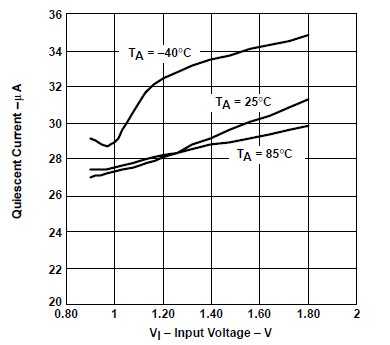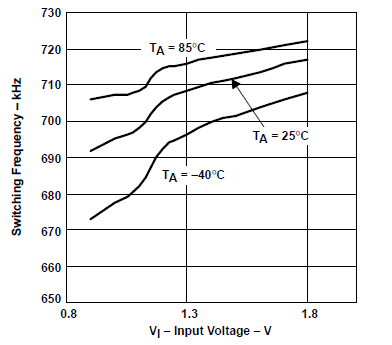SLVS302B December 2000 – October 2015 TPS60300 , TPS60301 , TPS60302 , TPS60303
PRODUCTION DATA.
- 1 Features
- 2 Applications
- 3 Description
- 4 Revision History
- 5 Description (continued)
- 6 Device Comparison Table
- 7 Pin Configuration and Functions
- 8 Specifications
- 9 Detailed Description
- 10Application and Implementation
- 11Power Supply Recommendations
- 12Layout
- 13Device and Documentation Support
- 14Mechanical, Packaging, and Orderable Information
Package Options
Mechanical Data (Package|Pins)
- DGS|10
Thermal pad, mechanical data (Package|Pins)
Orderable Information
8 Specifications
8.1 Absolute Maximum Ratings
Over operating free-air temperature range (unless otherwise noted) (1)| MIN | MAX | UNIT | ||
|---|---|---|---|---|
| VIN | Input voltage (IN to GND)(2) | –0.3 | 2 | V |
| VOUT | Output voltage (OUT1,OUT2, EN, PG to GND)(2) | –0.3 | V | |
| Voltage (C1+ to GND) | –0.3 | V | ||
| Voltage (C1– to GND, C2– to GND) | –0.3 | V | ||
| Voltage (C2+ to GND) | –0.3 | V | ||
| IOUT | Output current (OUT1) | 80 | mA | |
| IOUT | Output current (OUT2) | 40 | mA | |
| TJ | Maximum junction temperature | 150 | °C | |
| Tstg | Storage temperature | –55 | 150 | °C |
(1) Stresses beyond those listed under Absolute Maximum Ratings may cause permanent damage to the device. These are stress ratings only, which do not imply functional operation of the device at these or any other conditions beyond those indicated under Recommended Operating Conditions. Exposure to absolute-maximum-rated conditions for extended periods may affect device reliability.
(2) The voltage at EN and PG can exceed IN up to the maximum rated voltage without increasing the leakage current drawn by these pins.
8.2 ESD Ratings
| VALUE | UNIT | |||
|---|---|---|---|---|
| V(ESD) | Electrostatic discharge | Human-body model (HBM), per ANSI/ESDA/JEDEC JS-001(1) | ±2000 | V |
| Charged-device model (CDM), per JEDEC specification JESD22-C101(2) | ±500 | |||
(1) JEDEC document JEP155 states that 500-V HBM allows safe manufacturing with a standard ESD control process.
(2) JEDEC document JEP157 states that 250-V CDM allows safe manufacturing with a standard ESD control process.
8.3 Recommended Operating Conditions
Over operating free-air temperature range (unless otherwise noted)| MIN | NOM | MAX | UNIT | ||
|---|---|---|---|---|---|
| VIN | Input voltage | 0.9 | 1.8 | V | |
| IOUT(OUT2) | Output current (OUT2) | 20 | mA | ||
| IOUT(OUT1) | Output current (OUT1) | 40 | mA | ||
| CIN | Input capacitor | 1 | µF | ||
| C1F, C2F | Flying capacitors | 1 | µF | ||
| COUT(1) | Output capacitor | 1 | µF | ||
| COUT(2) | Output capacitor | 1 | µF | ||
| TJ | Operating junction temperature | –40 | 125 | °C | |
8.4 Thermal Information
| THERMAL METRIC(1) | TPS6030x | UNIT | |
|---|---|---|---|
| DGS (VSSOP) | |||
| 10 PINS | |||
| RθJA | Junction-to-ambient thermal resistance | 156.1 | °C/W |
| RθJC(top) | Junction-to-case (top) thermal resistance | 53.0 | °C/W |
| RθJB | Junction-to-board thermal resistance | 75.5 | °C/W |
| ψJT | Junction-to-top characterization parameter | 5.4 | °C/W |
| ψJB | Junction-to-board characterization parameter | 74.3 | °C/W |
(1) For more information about traditional and new thermal metrics, see the Semiconductor and IC Package Thermal Metrics application report (SPRA953).
8.5 Electrical Characteristics
CIN = C1F = C2F = C(OUT1) = C(OUT2) = 1 µF, TC = –40°C to 85°C, VIN = 1 V, V(EN) = VIN (unless otherwise noted)| PARAMETER | TEST CONDITIONS | MIN | TYP | MAX | UNIT | |||
|---|---|---|---|---|---|---|---|---|
| VIN | Supply voltage range | 0.9 | 1.8 | V | ||||
| IOUT(OUT1) | Maximum output current for TPS60300, TPS60302 | VIN ≥ 1.1 V, IOUT(OUT2) = 0 mA, I(PG,1) = 0 mA | 40 | mA | ||||
| VIN = 0.9 V, IOUT(OUT2) = 0 mA, I(PG,1) = 0 mA | 20 | |||||||
| IOUT(OUT2) | VIN ≥ 1.1 V, IOUT(OUT1) = 0 mA, I(PG,1) = 0 mA | 20 | mA | |||||
| VIN = 0.9 V, IOUT(OUT1) = 0 mA, I(PG,1) = 0 mA | 10 | |||||||
| IOUT(OUT1) | Maximum output current for TPS60301, TPS60303 | VIN ≥ 1.1 V, IOUT(OUT2) = 0 mA, I(PG,1) = 0 mA | 40 | mA | ||||
| VIN = 0.9 V, IOUT(OUT2) = 0 mA, I(PG,1) = 0 mA | 20 | |||||||
| IOUT(OUT2) | VIN ≥ 1 V, IOUT(OUT1) = 0 mA, I(PG,1) = 0 mA | 20 | mA | |||||
| VIN = 0.9 V, IOUT(OUT1) = 0 mA, I(PG,1) = 0 mA | 12 | |||||||
| VOUT(OUT2) | Output voltage for TPS60300, TPS60302 | 1.1 V < VIN < 1.8 V, IOUT(OUT1) = 0 mA, 0 < IOUT(OUT2) < 20 mA |
3.17 | 3.30 | 3.43 | V | ||
| 0.9 V < VIN < 1.1 V, IOUT(OUT1) = 0 mA, IOUT(OUT2) < 10 mA |
3.17 | 3.30 | 3.43 | |||||
| VOUT(OUT2) | Output voltage for TPS60301, TPS60303 | 1.0 V < VIN < 1.8 V, IOUT(OUT1) = 0 mA, 0 < IOUT(OUT2) < 20 mA |
2.88 | 3 | 3.12 | V | ||
| VIN > 1.65 V, IOUT(OUT1) = 0 mA, 25 µA < IOUT(OUT2) < 20 mA |
2.88 | 3 | 3.15 | |||||
| VP–P | Output voltage ripple | OUT2 | IOUT(OUT2) = 20 mA, IOUT(OUT1) = 0 mA | 20 | mVP–P | |||
| OUT1 | IOUT(OUT1) = 40 mA, IOUT(OUT2) = 0 mA | 40 | ||||||
| IQ | Quiescent current (no-load input current) | IOUT(OUT) = 0 mA, VIN = 1.8 V | 35 | 70 | µA | |||
| I(SD) | Shutdown supply current | VIN = 1.8 V, V(EN) = 0 V(1) | 0.05 | 2.5 | µA | |||
| VIN = 1.8 V, V(EN) = 0 V, TC = 25°C(1) | 0.5 | |||||||
| fOSC | Internal switching frequency | 470 | 700 | 900 | kHz | |||
| VIL(EN) | EN input low voltage | VIN = 0.9 V to 1.8 V | 0.3 × VIN | V | ||||
| VIH(EN) | EN input high voltage | VIN = 0.9 V to 1.8 V | 0.7 × VIN | V | ||||
| Ilkg | EN input leakage current | V(EN) = 0 V or VIN or VOUT(OUT2) or VOUT(OUT1) | 0.01 | 0.1 | µA | |||
| LinSkip switching threshold | VIN = 1.25 V | 7.5 | mA | |||||
| Short circuit current | VIN = 1.8 V | VOUT(OUT2) = 0 V | 5 | 20 | 50 | mA | ||
| VOUT(OUT1) = 0 V | 2 | 80 | 150 | |||||
| Output leakage current | OUT2 | VO(OUT1) = 3 V, VOUT(OUT2) = nominal, EN = 0 V | 1 | µA | ||||
| Output load regulation | VIN = 1.25 V, TC = 25°C, 2 mA < IOUT(OUT2) < 20 mA | 0.1 | %/mA | |||||
| Output line regulation | 1 V < VIN < 1.65 V; TC = 25°C, IOUT(OUT) = 10 mA | 0.75 | %/V | |||||
| No-load start-up time | 400 | µs | ||||||
| Impedance of first charge pump stage | 4 | Ω | ||||||
| Start-up performance at OUT2 (minimum start-up load resistance) | VIN ≥ 1.1 V | 165 | Ω | |||||
| VIN ≥ 1 V | 330 | |||||||
| VIN = 0.9 V | 1000 | |||||||
| Start-up performance at OUT1 (minimum start-up load resistance) | VIN = 1 V | 500 | Ω | |||||
| FOR POWER GOOD COMPARATOR: | ||||||||
| V(PG) | Power good trip voltage | VOUT ramping positive | VOUT – 2% | VOUT | V | |||
| Vhys | Power good trip voltage hysteresis | VOUT ramping negative | 10% | |||||
| VOL | Power good output voltage low | VOUT = 0 V, I(PG) = 1.6 mA | 0.3 | V | ||||
| Ilkg | Power good leakage current | TPS60300 | VOUT = 3.3 V, V(PG) = 3.3 V | 0.01 | 0.1 | |||
| TPS60301 | VOUT = 3 V, V(PG) = 3 V | 0.01 | 0.1 | µA | ||||
| VOH | Power good output voltage high | TPS60303 | I(PG) = –5 mA | 3 | V | |||
| TPS60302 | 2.7 | |||||||
| IOUT(PG,0) | Output current at power good (sink) | All devices | V(PG) = 0 V | 1.6 | mA | |||
| R(PG,1) | Output resistance at power good | TPS60302, TPS60303 | V(PG) = VO(OUT2) | 15 | Ω | |||
| R(PG,0) | All devices | V(PG) = 0 V | 100 | Ω | ||||
(1) OUT1 not loaded. If OUT1 is connected to GND through a resistor, leakage current will be increased.
8.6 Typical Characteristics
 Figure 1. TPS6030x
Figure 1. TPS6030x Quiescent Current vs Input Voltage
 Figure 2. Switching Frequency vs Input Voltage
Figure 2. Switching Frequency vs Input Voltage